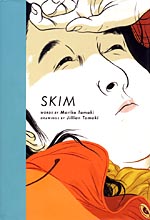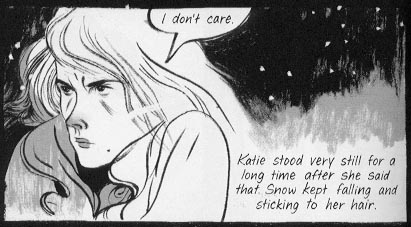 Written by Mariko Tamaki
Written by Mariko Tamaki
Art by Jillian Tamaki
144 pages, black and white
Published by Groundwood Books
I don’t know why it’s taken me so long to read Skim. I enjoyed Mariko Tamaki’s graphic novel with Steve Rolston, Emiko Superstar, and Skim‘s received nothing but accolades since its publication a year ago. Recently I pulled it off of the massive, swaying pile of "books to be read" and within a matter of pages, realized that I’d made a huge mistake by waiting this long to read Mariko and Jillian Tamaki’s book.
What grabbed me right from the start about Skim was that while high school dramas are a dime a dozen, this one felt very unflinching and real in a way that few seem to manage. All of the cruelty, confusion, and excitement of that time period is tied up into a tight knot within the pages of Skim, and it’s hard to separate one part from the other. So it’s a book about Kim, a non-popular student at a private school that gets turned upside down when a student’s ex-boyfriend commits suicide. But as much as it’s about Kim and her friends and relationships, it’s also a book about high school in general, about the cliques and movements that gain traction in the wake of a tragedy, and about how high school can be the cruelest time of one’s life—even if you are one of the popular kids.
 Mariko Tamaki’s dialogue blisters on the page; she’s got a real ear for how high school students talk, both around each other and when they’re alone. Mariko Tamaki uses the device of a diary to help bring a lot of Kim’s thoughts to the forefront, but it’s never overused or comes across as trite. I love that the "voice" that Mariko Tamaki uses in the diary is different than how Kim talks out loud or even thinks; Mariko Tamaki certainly remembers the overly dramatic way that kids would write in their own diaries. The dialogue is such an important part of this book; the uncomfortable conversations between Kim and her classmates wouldn’t be half as awkward or uncomfortable without all the little pauses, wrong words, and missed opportunities that hang in the air from one moment to the next. Kim’s problems with her best friend Lisa are sometimes best summed up by what Mariko Tamaki doesn’t have Kim say. The avoided phone calls, the ducking out of social settings, it all comes back around in a way that helps you feel Kim’s growing isolation and confusion caused by everyone around her. Then again, Skim is a book where it’s in part about what’s never said. When one character departs before the conclusion of the book, no one ever comes out and says, "Here’s what happened behind the scenes." There are hints of what may have happened, but it’s wonderfully and deliberately left vague and up to the reader to try and puzzle through what Kim herself refuses to see.
Mariko Tamaki’s dialogue blisters on the page; she’s got a real ear for how high school students talk, both around each other and when they’re alone. Mariko Tamaki uses the device of a diary to help bring a lot of Kim’s thoughts to the forefront, but it’s never overused or comes across as trite. I love that the "voice" that Mariko Tamaki uses in the diary is different than how Kim talks out loud or even thinks; Mariko Tamaki certainly remembers the overly dramatic way that kids would write in their own diaries. The dialogue is such an important part of this book; the uncomfortable conversations between Kim and her classmates wouldn’t be half as awkward or uncomfortable without all the little pauses, wrong words, and missed opportunities that hang in the air from one moment to the next. Kim’s problems with her best friend Lisa are sometimes best summed up by what Mariko Tamaki doesn’t have Kim say. The avoided phone calls, the ducking out of social settings, it all comes back around in a way that helps you feel Kim’s growing isolation and confusion caused by everyone around her. Then again, Skim is a book where it’s in part about what’s never said. When one character departs before the conclusion of the book, no one ever comes out and says, "Here’s what happened behind the scenes." There are hints of what may have happened, but it’s wonderfully and deliberately left vague and up to the reader to try and puzzle through what Kim herself refuses to see.
Jillian Tamaki’s art for Skim is beautiful, almost dreamy the way that it drifts across the page. The main focus of Jillian Tamaki’s art is definitely in the people, and from the flows of the women’s hair to the body language of the different students, I love how you can almost feel them moving from one panel to the next. In a book where everyone wears the same school uniform, Jillian Tamaki has a real challenge to make everyone look unique, but she certainly does just that. Special attention is certainly laid on the main character of Kim, and in some ways I love those drawings the most. Nicknamed "Skim" because of not being super-skinny, Jillian Tamaki carefully draws her not as a fat caricature of a person, but merely as someone who is more solid than some of her classmates.  It’s never exaggerated or over the top, and it makes it that much more of a realistic (and cruel) book. The backgrounds of Skim are beautiful too; from the woods behind the school where Kim begins to kiss someone else amongst the brush and trees, to the scattered dishes and jumbled possessions of Ms. Archer’s home, everywhere feels so real that it helps ease the reader into the book and become immersed in its contents.
It’s never exaggerated or over the top, and it makes it that much more of a realistic (and cruel) book. The backgrounds of Skim are beautiful too; from the woods behind the school where Kim begins to kiss someone else amongst the brush and trees, to the scattered dishes and jumbled possessions of Ms. Archer’s home, everywhere feels so real that it helps ease the reader into the book and become immersed in its contents.
Skim is a book about so many different things, but one piece of the story that kept coming back to me even after I finished the book was how Mariko Tamaki writes about depression. It’s a huge part of the book, although not in the way that you might expect it. In some ways the threat of being labeled as depressed is used as a weapon, lashing out against others and pushed in their faces by supposedly well-meaning organizations and groups. It’s a startling but real depiction of how events often unravel, and I have to commend Mariko Tamaki for not backing off the uncomfortable moments and situations. Then again, that’s how I feel about Skim in general. It’s a strong book, and Mariko and Jillian Tamaki deserve all the praise they’ve received for the book and then some. It’s quite excellent.
Purchase Links: Amazon.com | Powell’s Books
